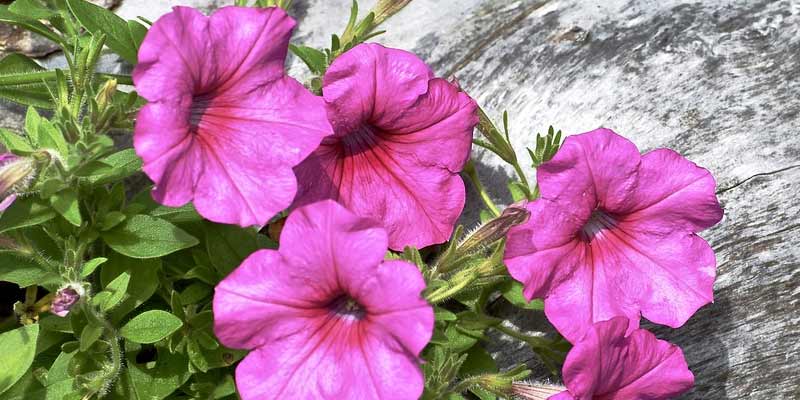Gardeners cherish petunias for their versatility, stunning array of colors, and prolific blooms that thrive in various settings: cascading from hanging baskets; adorning flower beds, or accentuating container gardens. These vibrant flowers bring a burst of color, and a touch of charm to any landscape. Yet, among gardening enthusiasts, one question frequently emerges: do petunias propagate?
This comprehensive guide delves into the growth habits of petunias: their spreading tendencies; factors that influence their development, and strategies for managing this growth in various garden settings.
Understanding Petunias
To comprehend the nature of petunias, members of the Solanaceae family and native to South America; one must first understand their propensity for spreading. Warm-season annuals or short-lived perennials are prized for their vibrant flowers and lush foliage.
Various forms exist within the petunia species: grandiflora, multiflora, milliflora; trailing types also make up this diverse array — each presenting unique growth habits and characteristics.
Do Petunias Spread?
Largely dependent on the specific cultivar or variety, environmental conditions, and cultural practices dictate the spreading habits of petunias. Unlike certain ground covers or invasive plants, petunias generally do not exhibit aggressive spreading tendencies.
Nonetheless, Wave petunias, Surfinia petunias along with other cascading cultivars like trailing varieties naturally trail and spread making them excellent choices for ground covers or hanging baskets use.
Trailing Petunias
Trailing or spreading petunias, such as Wave varieties, exhibit vigorous growth habits characterized by long cascading stems. These lush and colorful mats sprawl along the ground or spill over container edges – their extensive range often extending several feet in all directions; a testament to their robustness.
Trailing petunias excel in filling gaps within garden borders or hiding bare patches of soil; however, their growth may necessitate periodic pruning to enforce containment and sustain an immaculate appearance.
Non-Trailing Petunias
Compact or bushy varieties of petunias, including grandiflora and multiflora types – classified as Non-Trailing Petunias exhibit a more upright growth habit; they do not spread as aggressively as their trailing counterparts.
These particular petunias culminate in tidy mounds of foliage and flowers–an attribute that renders them appropriate for flower beds, containers, and mixed plantings alike. Their growth, generally more contained than trailing petunias, may spread slightly as they mature.
4 Factors Influencing Petunia Growth
Several factors influence the growth habits and spreading tendencies of petunias:
1. Variety or Cultivar
Different varieties and cultivars of petunias exhibit a range of growth habits, from compact and upright to trailing or spreading. Choosing the appropriate variety, a decision based on the intended use as well as the garden space available can effectively manage petunia growth and spread.
2. Growing Conditions
Environmental factors sunlight, temperature, soil moisture, and fertility – significantly influence the growth and development of petunias. Thriving in full sunlight with well-drained soil; vigorous growth and flowering are supported by adequate moisture as well as fertility.
Providing optimal growing conditions can encourage healthy growth while minimizing excessive spreading.
3. Pruning and Deadheading
Regular pruning and deadheading control the growth and spread of petunias, particularly trailing varieties. This is accomplished through a process involving the removal of spent flowers, a practice that also encourages branching.
Additionally, trimming back leggy stems promotes compact; bushy growth–an effective method for preventing unruly or invasive tendencies in petunias.
Spacing and Planting Density
Proper spacing and planting density when cultivating petunias in garden beds or containers, one must consider the crucial elements of proper spacing and planting density.
It is imperative to allocate space for plants based on their mature size and growth habit; this allows adequate room for trailing varieties to spread out, and fill gaps without overcrowding, thus avoiding competition over resources.
Managing Petunia Growth in the Garden
Petunias, though typically not deemed invasive or aggressive spreaders, necessitate effective growth management for a maintained tidy, and well-balanced garden.
Regular Maintenance
Engage in routine maintenance tasks such as pruning, deadheading, and grooming petunias regularly to enhance their appearance; and prevent excessive spreading, a key factor for optimum growth. Promptly remove any damaged or diseased foliage: this is critical in maintaining plant health and vitality at its peak.
Containment Strategies
Utilize containment strategies like planting petunias in raised beds, containers, or hanging baskets to prevent their encroachment on neighboring plants or other sections of the garden. Further, define boundaries and confine spreading varieties within designated areas by considering the use of edging or barriers.
Selective Propagation
To maintain desired growth habits and prevent the spread of aggressive or unwanted varieties, selectively propagate petunias through stem cuttings or division. If any plants exhibit invasive tendencies or out-compete other garden plants for space and resources, discard them.
Regular Monitoring
Throughout the growing season, regularly monitor the growth and spread of petunias; and assess their health, vigor, and performance. As you detect any concerns or issues related to their growth and spread – swiftly adjust cultural practices as well as management strategies to address them.
Conclusion
Certain trailing varieties of petunias, although not typically aggressive spreaders, naturally tend to trail and spread. This makes them valuable additions to gardens, containers, and hanging baskets. If gardeners understand the growth habits of these plants and implement suitable management strategies; they can enjoy both the beauty and versatility that beloved flowering petunias offer while maintaining an environment in their garden that is well-balanced and harmonious.
Through proper care, including maintenance as well as selective propagation, it is possible for these versatile blooms to thrive outdoors and enhance spaces with vibrant colors while exhibiting graceful growth habits – a source not only delight to dedicated cultivators but also casual observers who appreciate enduring charm intertwined with natural beauty.



Leave a Reply